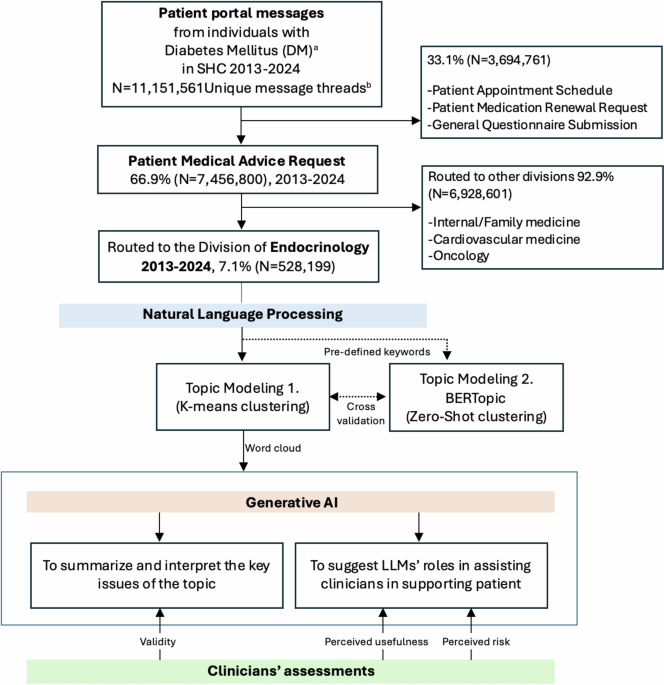Artificial intelligence tools in supporting healthcare professionals for tailored patient care

Lancet, T. Diabetes: a defining disease of the 21st century. Lancet 401, 2087 (2023).
Google Scholar
Harding, J. L., Pavkov, M. E., Magliano, D. J., Shaw, J. E. & Gregg, E. W. Global trends in diabetes complications: a review of current evidence. Diabetologia 62, 3–16 (2019).
Google Scholar
Rustad, J. K., Musselman, D. L. & Nemeroff, C. B. The relationship of depression and diabetes: pathophysiological and treatment implications. Psychoneuroendocrinology 36, 1276–1286 (2011).
Google Scholar
Khaledi, M., Haghighatdoost, F., Feizi, A. & Aminorroaya, A. The prevalence of comorbid depression in patients with type 2 diabetes: an updated systematic review and meta-analysis on huge number of observational studies. Acta Diabetol. 56, 631–650 (2019).
Google Scholar
Dal Canto, E. et al. Diabetes as a cardiovascular risk factor: an overview of global trends of macro and micro vascular complications. Eur. J. Prev. Cardiol. 26, 25–32 (2019).
Google Scholar
Hills, A. P. et al. Epidemiology and determinants of type 2 diabetes in South Asia. Lancet Diab. Endocrinol. 6, 966–978 (2018).
Google Scholar
Powers, M. A. et al. Diabetes self-management education and support in adults with type 2 diabetes: a consensus report of the american diabetes association, the association of diabetes care & education specialists, the academy of nutrition and dietetics, the American Academy of Family Physicians, the American Academy of PAs, the American Association of Nurse Practitioners, and the American Pharmacists Association. Diabetes Care 43, 1636–1649 (2020).
Google Scholar
Kupfer, J. M. & Bond, E. U. Patient satisfaction and patient-centered care: necessary but not equal. JAMA 308, 139–140 (2012).
Google Scholar
Bierman, A. S. & Tinetti, M. E. Precision medicine to precision care: managing multimorbidity. Lancet 388, 2721–2723 (2016).
Google Scholar
Williams, J. S., Walker, R. J., Smalls, B. L., Hill, R. & Egede, L. E. Patient-centered care, glycemic control, diabetes self-care, and quality of life in adults with type 2 diabetes. Diabetes Technol. Ther. 18, 644–649 (2016).
Google Scholar
Davies, M. J. et al. Management of hyperglycemia in type 2 diabetes, 2018. a consensus report by the American Diabetes Association and the European Association for the study of diabetes. Diabetes Care 41, 2669–2701 (2018).
Google Scholar
Rutten, G. E. H. M., Van Vugt, H. & de Koning, E. Person-centered diabetes care and patient activation in people with type 2 diabetes. BMJ Open Diabetes Res. Care 8, e001926 (2020).
Google Scholar
Asmat, K., Dhamani, K., Gul, R. & Froelicher, E. S. The effectiveness of patient-centered care vs. usual care in type 2 diabetes self-management: a systematic review and meta-analysis. Front. Public Health 10, 994766 (2022).
Google Scholar
Wade-Vuturo, A. E., Mayberry, L. S. & Osborn, C. Y. Secure messaging and diabetes management: experiences and perspectives of patient portal users. J. Am. Med. Inform. Assoc. 20, 519–525 (2013).
Google Scholar
Holmgren, A. J. et al. Assessing the impact of the COVID-19 pandemic on clinician ambulatory electronic health record use. J. Am. Med. Inform. Assoc. 29, 453–460 (2022).
Google Scholar
Sun, R., Blayney, D. W. & Hernandez-Boussard, T. Health management via telemedicine: learning from the COVID-19 experience. J. Am. Med. Inform. Assoc. JAMIA 28, 2536–2540 (2021).
Google Scholar
Kumar, A. et al. Is diabetes mellitus associated with mortality and severity of COVID-19? A meta-analysis. Diabetes Metab. Syndr. 14, 535–545 (2020).
Google Scholar
Brands, M. R. et al. Patient-centered digital health records and their effects on health outcomes: systematic review. J. Med. Internet Res. 24, e43086 (2022).
Google Scholar
Sarraju, A. et al. Identifying reasons for statin nonuse in patients with diabetes using deep learning of electronic health records. J. Am. Heart Assoc. 12, e028120 (2023).
Google Scholar
Chung, S., Panattoni, L., Chi, J. & Palaniappan, L. Can secure patient-provider messaging improve diabetes care? Diabetes Care 40, 1342–1348 (2017).
Google Scholar
Somani, S., van Buchem, M. M., Sarraju, A., Hernandez-Boussard, T. & Rodriguez, F. Artificial intelligence–enabled analysis of statin-related topics and sentiments on social media. JAMA Netw. Open 6, e239747 (2023).
Google Scholar
Uncovska, M., Freitag, B., Meister, S. & Fehring, L. Rating analysis and BERTopic modeling of consumer versus regulated mHealth app reviews in Germany. NPJ Digit. Med. 6, 115 (2023).
Google Scholar
Rajpurkar, P., Chen, E., Banerjee, O. & Topol, E. J. AI in health and medicine. Nat. Med. 28, 31–38 (2022).
Google Scholar
Beam, K. et al. Performance of a large language model on practice questions for the neonatal board examination. JAMA Pediatr. 177, 977–979 (2023).
Google Scholar
Strong, E. et al. Chatbot vs medical student performance on free-response clinical reasoning examinations. JAMA Intern. Med. 183, 1028–1030 (2023).
Google Scholar
Kim, J., Cai, Z. R., Chen, M. L., Simard, J. F. & Linos, E. Assessing biases in medical decisions via clinician and AI chatbot responses to patient vignettes. JAMA Netw. Open 6, e2338050 (2023).
Google Scholar
Martens, T. et al. Effect of continuous glucose monitoring on glycemic control in patients with type 2 diabetes treated with basal insulin: a randomized clinical trial. JAMA 325, 2262–2272 (2021).
Google Scholar
Lee, Y.-B. et al. An integrated digital health care platform for diabetes management with ai-based dietary management: 48-week results from a randomized controlled trial. Diabetes Care 46, 959–966 (2023).
Google Scholar
Ganguli, I., Orav, E. J., Lupo, C., Metlay, J. P. & Sequist, T. D. Patient and visit characteristics associated with use of direct scheduling in primary care practices. JAMA Netw. Open 3, e209637 (2020).
Google Scholar
WHO issues warning on falsified medicines used for diabetes treatment and weight loss. (WHO, 2024).
Manshahia, P. K. et al. Systematic review to gauge the effect of levothyroxine substitution on progression of diabetic nephropathy in patients with hypothyroidism and type 2 diabetes mellitus. Cureus 15, e44729 (2023).
Google Scholar
Sellmeyer, D. E. et al. Skeletal metabolism, fracture risk, and fracture outcomes in type 1 and type 2 diabetes. Diabetes 65, 1757–1766 (2016).
Google Scholar
Ferrari, S. L. et al. Diagnosis and management of bone fragility in diabetes: an emerging challenge. Osteoporos. Int. 29, 2585–2596 (2018).
Google Scholar
Wu, B. et al. A narrative review of diabetic bone disease: characteristics, pathogenesis, and treatment. Front. Endocrinol. 13, 1052592 (2022).
Google Scholar
Patel, V., Fancourt, D., Furukawa, T. A. & Kola, L. Reimagining the journey to recovery: the COVID-19 pandemic and global mental health. PLOS Med 20, e1004224 (2023).
Google Scholar
Kim, J. et al. Prevalence and associations of poor mental health in the third year of COVID-19: U.S. population-based analysis from 2020 to 2022. Psychiatry Res. 330, 115622 (2023).
Google Scholar
Swaminathan, A. et al. Natural language processing system for rapid detection and intervention of mental health crisis chat messages. npj Digit. Med. 6, 1–9 (2023).
Google Scholar
Kim, J. et al. Telehealth utilization and associations in the united states during the third year of the covid-19 pandemic: population-based survey study in 2022. JMIR Public Health Surveill. 10, e51279 (2024).
Google Scholar
sentence-transformers/all-MiniLM-L6-v2 · Hugging Face. (2024).
Rousseeuw, P. J. Silhouettes: a graphical aid to the interpretation and validation of cluster analysis. J. Comput. Appl. Math. 20, 53–65 (1987).
Google Scholar
Davies, D. L. & Bouldin, D. W. A cluster separation measure. IEEE Trans. Pattern Anal. Mach. Intell. PAMI-1, 224–227 (1979).
Devlin, J., Chang, M.-W., Lee, K. & Toutanova, K. BERT: pre-training of deep bidirectional transformers for language understanding. in Proceedings of the 2019 Conference of the North American Chapter of the Association for Computational Linguistics: Human Language Technologies, Volume 1 (Long and Short Papers) (eds. Burstein, J., Doran, C. & Solorio, T.) 4171–4186 (Association for Computational Linguistics, Minneapolis, Minnesota, 2019). https://doi.org/10.18653/v1/N19-1423.
thenlper/gte-small · Hugging Face. https://huggingface.co/thenlper/gte-small.
Leypold, T., Schäfer, B., Boos, A. & Beier, J. P. Can AI think like a plastic surgeon? Evaluating GPT-4’s clinical judgment in reconstructive procedures of the upper extremity. Plast. Reconstr. Surg. Glob. Open 11, e5471 (2023).
Google Scholar
Kojima, T. et al. Large language models are zero-shot reasoners. Adv. Neural Inf. Process. Syst. 35, 22199–22213 (2022).
Artificial intelligence risk management framework (AI RMF 1.0) (NIST, 2023).
Chang, N., Lee-Goldman, R. & Tseng, M. Linguistic wisdom from the crowd. Proc. AAAI Conf. Hum. Comput. Crowdsour. 3, 1–8 (2015).
Google Scholar
Subjectivity, ambiguity and disagreement in crowdsourcing. (SAD, 2018).
link






